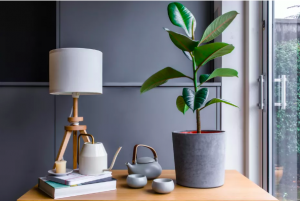No products in the cart.
Caring of Plants in Air Conditioning Leave a comment
How to take care of Plants in Air Conditioning
There are plants which can thrive in hot and hazy weather, especially tropical like Money plants and Dracaenas that are native to humid jungle habitats. The cool, dry air that’s comfortable for us is unfortunately not as beneficial for many houseplants. Now the question arises we all love green beauty in the place whether it’s our working station, living room, bedrooms etc. where we prefer to spend our time by turning on the air conditioning. The things which give us comfort might not be suitable especially for indoor plants. We must know how AC is affecting our greens, and in what way we can take care of our green beauties.

How Air Conditioning Affects Plants
The considerable overthrow for the plants that come from using air conditioning is lower temperatures and humidity. Here are a few signs that your plants are suffering from the cool, conditioned air in your home:
- The plant’s leaves are turning brown around the edges.
- The plant is beginning to droop.
- The plant is rapidly dropping leaves or petals.
- Either the plant growth has slowed down or stopped.
- Plant’s leaves are fading or turning yellow.
- The flowering plant stops flowering anymore.
There are a few tips or different ways in which one can combat the negative effects of air conditioning on your plants. The best part is that one doesn’t have to turn off their AC or risk giving up indoor gardening altogether.
How to take care of plants in an Air-Conditioned Room
In an air conditioning room, do not keep the plants in the direct path of the vent. Providing some moisture to the plants in the form of mist. In some cases, covering the entire plant can also help in keeping them warm while preventing them from drying out quickly.
There are a few steps one needs to follow like while keeping the plants in AC.
- Misting the plants every day helps them to restore their moisture stripped off by the chilly air. Make sure that plant is well-hydrated and gets enough water as per its needs.
- Avoid overwatering or over-saturation of roots as it may lead to root rot. The ideal humidity level for houseplants is between 40-60%, with tropical plants preferring the higher end of the range.

Practically it’s not possible to keep the entire home that humid. However, it is possible to create humid microclimates – small areas around your plants that retain more water vapour in the air. Here are a few strategies to try: –
- Use pebble trays: In a shallow tray place, a layer of pebbles add water until the pebbles are not quite covered and set the potted plant on top. By doing so, the pebbles hold the plant above the water, so the roots are not submerged. The water in the tray continually evaporates, increasing the moisture in the air around the plant.
- Add a humidifier: This is one of the most effective options and can be beneficial for plants and humans alike. Adding humidity to dry rooms will keep your plants hydrated and prevent you from developing dry, irritated skin.
- Keeping plants in a group altogether: By placing plants in groups one can create a pocket of increased humidity. As the plants transpire, water vapour is released into the air and trapped within their crowded canopies. Place a dish of water in the centre of the plants to further increase the amount of water vapour in the air.
- Clean the dust from your plants daily. Remove shredded leaves, flowers and buds from the pot. This practice helps to keep plants healthy and undisturbed by pests and diseases. During the daytime, 65 ° – 80 ° Fahrenheit temperature is pleasant for plants. But, at night, keep it between 55° – 65 °.
- Apply mulch to the soil around the plant. It will protect the roots of the plant.
- Plants thrive in air-conditioned rooms until their leaves encounter the blast of freezing air. So, whenever you find that your plant leaves turn yellow or brown, don’t think twice and immediately change their location to save them from drying out.
Where to place the plant in Air Conditioner
The distance between an air conditioner and your plants depends on how big the room is, what type of plant you are growing, and whether it is an indoor or outdoor plant. As per general guidelines, one should keep up a minimum of 6 feet of distance between your plants and the AC vent. Naturally, it becomes difficult for the plants to stand in the way the freezing air from the vent passes through. Scientifically speaking the greater the temperature range and temperature difference between an A/C and a plant, the greater the effect on the plant, so it becomes very much essential to select only those plants that can withstand high temperatures.
Best Plants for Air-Conditioned Rooms:
Hence, for your convenience, we came up with a list of plants that can do well even in an air-conditioned room.
- Rubber Plant
- Prickly Pear
- Spider Plant
- Pothos Golden Money Plant
- Snake Plant (Mother-in-law’s tongue)
- Peace Lily (Flowering plant)
- Parlour Palm
- Monstera Plant
- ZZ Plant or Zamioculcas zamiifolia
All the plants mentioned above need minimal maintenance. They can thrive in any environmental conditions. They need little care and attention; they keep the air fresh and breathable. Most of them are drought tolerant. Moreover, they can easily survive in low light and sometimes in darkness as well. Keeping plants with large leaves is preferable as they are more adaptable to your AC room and will tend to be more tolerant of temperature swings produced by AC systems.
Featured Image by : <a href=”https://www.freepik.com/free-photo/brown-sofa-wooden-table-living-room-interior-with-plant-concrete-wall_15681913.htm#query=plants%20in%20room&position=21&from_view=search”>Image by vanitjan</a> on Freepik



